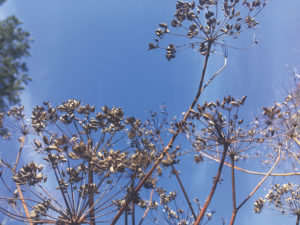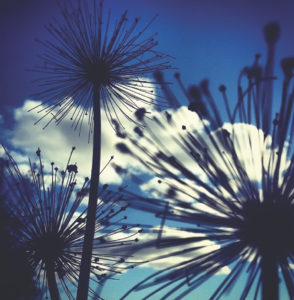I used to rent a small house with large windows. The windows overlooked a meadow of grasses and wildflowers framed at its edges by low oaks and autumn olive. In the days of summer, of lush green and fullness, of breezes that push through blades of grass, the meadow was nearly overwhelming in its richness. There was energy and growth, constant motion, competition, flowers, and color.
As the seasons passed, and then the years, I became aware of a change, both in the meadow and in myself. I started to look forward to seeing my meadow in the winter. I loved the color and the energy of the warm season, but it wanted so much attention. It demanded constant vigilance; if I failed to look every day, something might be missed.

In the fall, as the nights grew longer and the petals dropped away from the flowers, the leaves browned, curled, and fell, and the truth of the meadow was revealed. Here was the naked bone structure behind summer’s full, soft face. The structures that supported the leaves and flowers stood, still and black in the wet mornings, sculptures against a stark backdrop. The stoic forms of seed heads and the skeletons of flowers remained against the wind and rain, a reminder of the bones required to support summer’s softer expressions of beauty. The winter garden is bare and simple and honest.
Most of us plan our gardens and search our landscapes only for their flowers. But the structures left standing when the softer parts fall away are as intricate and delightful as any flower. They do not advertise loudly; they do not ask to be looked at. They require a more discerning eye and a bit of patience, something the slower days of winter afford and encourage.
There is a Dutch landscape designer who has brought a great deal of attention and appreciation to this idea. Piet Oldouf creates vast, stunning fields and meadows. He works using large swaths of color, broad brush strokes of texture and massing, and designs with great emphasis on the winter garden. His gardens are amazing in all their seasons, but reveal their genius in the winter. When they are etched in frost, wrapped in a winter haze, they will make you go still, sit down, and weep.
“The garden in winter is an emotional experience,” he says. “You think in terms of decay and disappearing and coming back. You feel the life cycle of nature. If you make a four-season garden you have to learn to accept decay and see the beauty of it. It’s about texture and shape, the seed heads and the skeletons. So instead of using the scissors, you use your eyes.”
This time of year, we go to our gardens with pruners and cut them down. It gives us a clean slate to begin again the follow spring. It looks clean and helps our minds feel organized and clear. But what if we left some of the more enduring structures? Let the sedum stand and watch as it collects a cloud of snow on its dark branches. Leave the elegant firework forms of the Queen Anne’s lace and the allium and let them be draped in spider webs. Wait until early spring to cut the Echinacea, which will feed the birds, the Actaea, with its spiraling stems, the cinnamon plumes of the astilbe, and let the dew settle on the tall, powerful spikes of the Verbascum.

Nature is an architect. In her ceaseless mission to protect and perpetuate life, she has developed shapes and structures to serve this function. These forms and patterns resonate in us. They speak to us on a level deeper than aesthetics alone. They are the inspiration for the things we find beautiful and sublime. The vaulted ceilings of a cathedral are not beautiful simply because they remind us of structures found in nature. They look that way because that’s what works. Because nature, in her incessant evolution, has discovered and created the most beautifully functional forms. We recognize these as beautiful because they are themselves the designs, shapes, and forms of life.
These forms are found in the winter garden. In the vaulted interiors of seed cases, the arching, umbel flower stems, in the fluted stalks that stand through the north wind and the snow. Our gardens are not dead in winter. They are sleeping. The winter is a time of rest and transition, of stillness and observation. There is decay, but there are also the quiet embers of life held within the sculpture forms standing in the fields and gardens.



